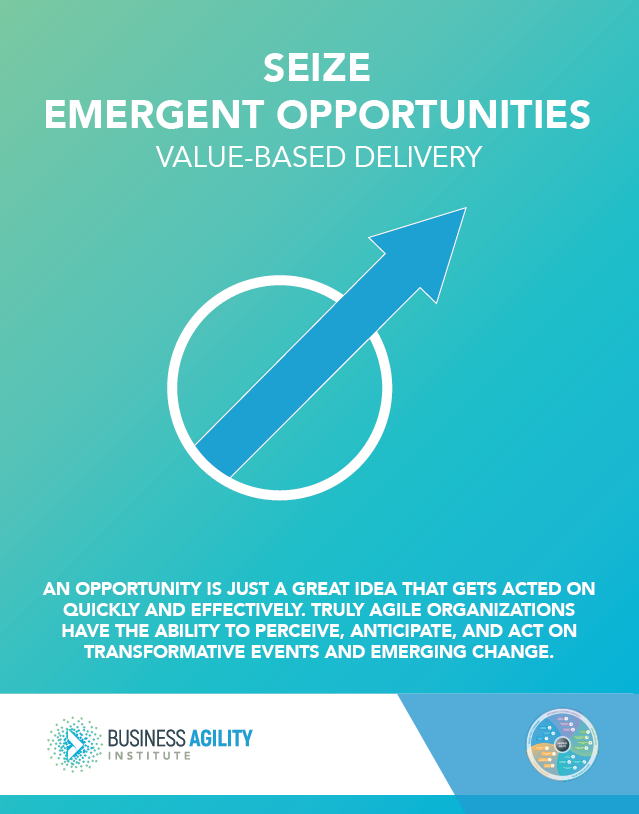Domains of Business Agility
- Responsive Customer-Centricity
- / Fiercely Champion The Customer
- / Sense & Respond Proactively
- / Integrate Diverse Ideas
- Engaged Culture
- / Cultivate A “Learning Organization”
- / Engage Transparently & Courageously
- / Embed Psychological Safety
- / Act As One
- Value-Based Delivery
- / Unleash Workflow Creatively
- / Prioritize. Prioritize. Prioritize.
- / Deliver Value Sooner
- / Seize Emergent Opportunities
- Flexible Operations
- / Adapt Strategies Seamlessly
- / Fund Work Dynamically
- / (Re)Organize Structures Fluidly
- / Balance Governance And Risk
- People-First Leadership
- / Foster Authentic Relationships
- / Empower With Accountability
- / Realize People’s Potential
An opportunity is just a great idea that gets acted on quickly and effectively. Truly agile organizations have the ability to perceive, anticipate, and act on transformative events and emerging change. Sometimes, when we realize that our customers have an unmet need, it’s an opportunity to expand how we serve them. Other times, an unanticipated event like the coronavirus pandemic of the 2020s brings opportunities to shift and address a global need.
To fully seize an emergent opportunity, organizations need to continuously anticipate and lower the cost of change. They must be able to see it and recognize it for what it is. They also need to evaluate the opportunity in the context of their current portfolio of products and services to assess whether it’s worth the investment. How critical is this opportunity for your customers, your business, the world? And finally, organizations need to be able to act on the opportunity at hand — potentially pivoting from current commitments to act fast before the opportunity becomes less attractive. When organizations cultivate business agility, they are able to assess and act on emergent opportunities without simply jumping on each opportunity that arises.
Primary Behaviors
The following 4 behaviors strongly contribute to seizing emergent opportunities.
B48: Leaders pivot work when a more valuable opportunity arises: When a new opportunity is sufficiently more valuable than the current work focus, leaders will shift the team to work on the new opportunity.
B49: Leaders delay commitments and keep important and irreversible decisions open as long as feasible: Leaders recognize that quick, irreversible decisions are not always the best option. In some cases (particularly when it’s a large-scale decision that will have a profound impact on the business) - it is important to keep as many options open for as long as possible.
B50: Leaders design work systems and processes so unplanned opportunities can be started quickly: Our processes (e.g. contract, procurement, funding models) are designed for unplanned and emergent work.
B51: Leaders build capacity into the system to accommodate emergent opportunities: Leaders help their organization quickly act on new opportunities by supporting people to shift their commitments, rather than by attempting to “just add one more thing” to the plan.


